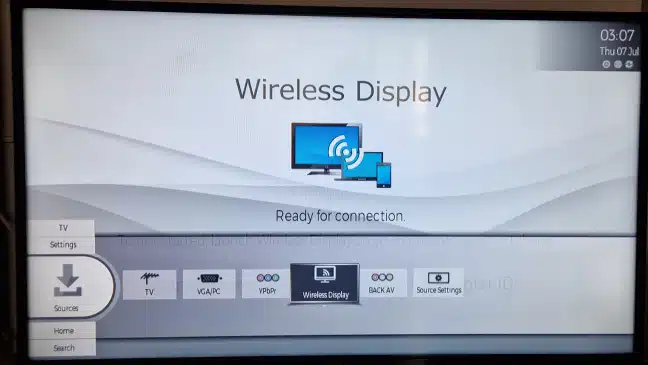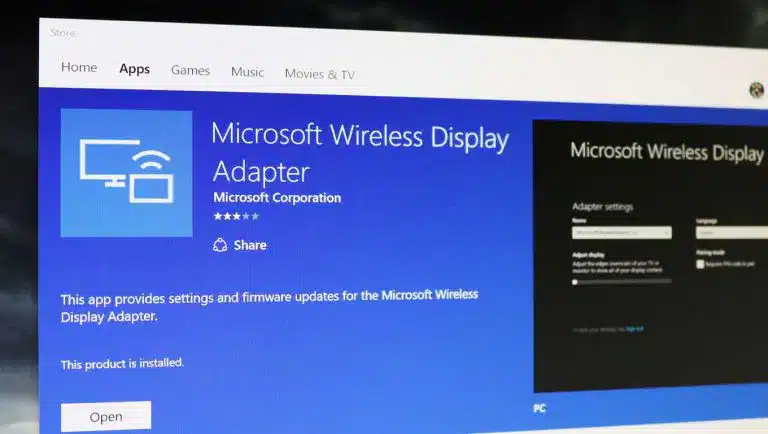Table of Contents
How to Connect Wireless Display to TV?
How To Connect Wireless Display To TV? If your TV supports Miracast, or you have a WiGig dock, you can wirelessly connect your Windows laptop to it. Make sure both your laptop and TV are on the same Wi-Fi network.
Plug one end of the Microsoft Wireless Display Adapter into an HDMI port on your TV. The other end goes into the TV’s powered USB charging port.
Connect the Laptop:
There are a few different methods for connecting a laptop to a TV. The most common involves running a wire from the laptop to the TV. This can be done using either a full-sized HDMI cable or an adapter such as a USB-C to HDMI adapter (this one is cheap and works great). The connection type will depend on what kind of ports are available on both the laptop and the TV. Most modern laptops will have full-sized HDMI ports, while older ones may use a different kind of connector such as VGA. This method requires a second cable that carries audio, as VGA cables only provide the video signal.
Once the wire or adapter is connected, turn on the TV and the laptop. On the TV, find and select the HDMI source — it will be labeled as PC or something similar. On the laptop, make sure to set the output to match the TV screen size and resolution. This can be done by pressing the Windows key and P or by opening the display settings on the Mac (click the Apple menu and then System Preferences).
Adjusting the laptop’s video output settings can help reduce input lag, especially when playing games. Some TVs also have a “Game Mode” setting that can be enabled to further improve performance.
Connect the TV:
If you have a modern Smart TV. You can connect it to your laptop wirelessly and mirror the computer screen on the TV. To do this, make sure that both devices are connected to the same. Wi-Fi network and turn on Bluetooth in Windows. Open the Settings app on your Windows 10 laptop and select “Multiple displays”. Look for your TV in the list and click it to connect.
If your TV doesn’t support HDMI, you can use a regular cable to connect the two devices. One end of the cable needs to be plugged into the port on your laptop or PC. (The type will vary by model) and the other into an HDMI or VGA port on your TV. Once the cable is in place, change the TV source to the HDMI input using your TV’s remote control.
Another simple way to connect your laptop to a TV is to use a USB flash drive. You can transfer files from your computer to the.

USB flash drive and then plug it into your TV. Some TVs will only play image files, while others support videos and other media as well. Just make sure that the TV supports your preferred file format before proceeding. If you don’t have a USB flash drive, you can buy one inexpensively from any store.
Connect the Adapter:
If your laptop doesn’t have a full-sized HDMI port, or if you have an older TV that does not support the technology, there are still ways to connect to it. The most basic way is to run a wire from your PC’s HDMI output to the TV. You can also use software like VLC to mirror your screen, or you can purchase a wireless HDMI display adapter.
Most of these devices have two plugs, one that goes into an HDMI port on your TV and the other that goes into a powered USB charging port on your laptop or a power supply unit for your Surface tablet. You will also need to change the TV input using your remote control to match the HDMI port into which you plugged the adapter.
The adapter itself will have its software, which may require installation and configuration on the computer. It may require you to connect to Wi-Fi and will have its app on the device, or you may be able to configure other settings using the laptop.
If you want to connect your Windows 10 laptop to a non-Miracast device. You’ll need a Microsoft Wireless Display Adapter (we will receive a commission if you purchase this item using this link). Connect it to the TV with the HDMI end and the USB end to any power source. On the Windows 10 laptop, open the Connect panel and select your TV. You’ll need to wait a minute or so for the device to connect.
Connect the Power:
If you have a wireless display adapter that supports Miracast. You can use it to connect your PC to your TV without running wires. To do so, turn on your laptop and TV and make sure they’re both connected to the same Wi-Fi network. Locate the video/data port on your laptop (usually an HDMI or USB-C port). And plug in the adapter or a cable with an HDMI connection on one end and. A compatible connector such as mini-DisplayPort, Thunderbolt, or USB-C on the other end. The TV should now show the desktop from the laptop.
If the screen is distorted or cut off, adjust your TV’s input resolution through its operating system settings. You can also use Chrome or AirPlay(r) to connect a mobile device. Like an Android phone or iPad(r), to your TV wirelessly.
If you have a Windows 10(r) laptop or tablet. Use the Microsoft Wireless Display Adapter, which has an HDMI connection. On one end and a powered USB charging port on the other. This type of adapter works best with TVs. They have an HDMI port but can work with some other types as well. To connect it to your TV. Open the Connect side panel on Windows and select the name of the TV in the list of available devices. This method can also work with some smart TVs and other wireless receivers that support Miracast.





Add comment